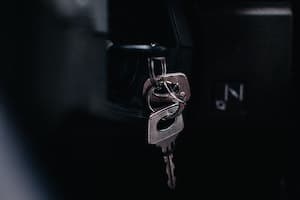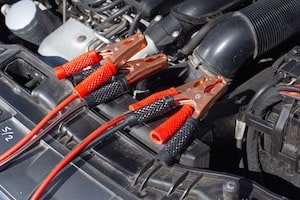Determining the cause of a car that won’t start can be very difficult. But it can also be simple and knowing the information presented in this post can save you loads of money and even help you in a situation where you may be stranded. On multiple occasions I have had my own personal car as well as friends cars not able to start and completely silent when turning the key. Thanks to trying a few basic things I was able to determine the reason the car would not start, and get us back on the road without much trouble.
The most common reason for a car not to start that is silent when turning the key is a dead battery or a poor battery terminal connection. It can be also be caused by a number of other things such as a blown fuse, the neutral safety switch, or a bad ground.
It does not ultimately mean that you need a new battery if your car does not make any noise when trying to start it. The battery is a likely cause but there are several things to try before you rule out the battery as the problem. The true problem can be narrowed to somewhere between the battery and the starter.
The precise cause can be determined by checking a few things like if your lights turn on, if the key fob works, and if the horn works. A simple step by step process can be followed to determine if the battery is the cause of your vehicle not starting. Also covered in this article are things such as how to tell if your alternator is the culprit and how to tell.

If your car will not start but is making noise then it could be an entirely different list of possible causes. Check out our other article about:
Rapid Clicking When Turning the Key – Car Won’t Start (How to Fix it)
My Car Does Not Make Any Noise When Turning the Key to Try and Start it
If my car does not make any noise at all when I try to start it does it mean I need a new battery?
A dead battery will cause a car to not start and be silent when turning the key. The best way to confirm that your battery is dead is to use a multimeter to measure the battery voltage. Another tell tale sign is to see if the lights come on and are bright. If they are then it may be caused by something other than the battery.
Attempting to honk the horn while the battery is dead is another good test.
Spark Fuel and Compression are the 3 Components Required for an engine to Run
For an engine in a car to run, the engine must be supplied with fuel, spark, and have compression.
The battery is what provides the power to the spark plugs as well as power to turn the engine over by the power of the starter. When you turn the key it allows electricity to flow to the starter to turn the engine and the ignition coil providing spark.
Once the starter turns the engine, spark is ignited once the cylinders are full of fuel and compress. This happens quickly to start the engine and from that point the engine will continue to run and drives the alternator which generates enough power to keep the battery charged and provide power for lights.
If your car is not making any noise while you turn the key to try and start the car, then either the starter has an issue or there is not sufficient power getting there.
Zero sound means the starter is not turning to try to rotate the engine so fuel or spark is not the problem
If fuel or spark is your problem then you will at least hear the starter turning the engine over.
If the lights do not turn on and you cannot use the key fob to lock unlock then battery is completely dead.
If the lights do come on then you have a poor connection causing enough resistance not allowing enough current to flow to the starter or a battery that is low enough that it does not have enough power for the starter.
Listen carefully to your car.
Is there any clicking when you turn the key? If there is one click then your battery is very low and may have sufficient power to turn on the lights, but not enough to power the starter which draws a lot of current. If other noises are made then check out our other post here about what the problem could be if the car is making noise but won’t start.
The battery is the first thing to check if your car is having difficulty starting because there are many possible causes but the battery is the easiest to check and to fix.
Ensure that the battery cables are tightly connected to the battery terminals and that the ground wire is securely and cleanly bolted to the frame or to the engine block.
If any of the battery connections look dirty, corroded, or loose, remove the wire and clean the contact points and reconnect the battery cables.
There are several more indicators to be certain that it is your car battery
The best way is to own a digital multimeter like this one. Good ones are not very expensive with this one linked to at about 35$ and is simple to use. Use a multimeter to do things like determine when your battery or alternator have gone bad or check if an outlet has power when troubleshooting basic electrical problems.
AAA does a battery service. If you determine that your battery is dead and find yourself stranded, don’t forget that AAA has a battery service where they can install a new battery for you. Or have it towed to an auto shop.
If none of these things are working but you are using a new battery or are sure that your battery is charged then the next thing to check is the battery terminals.
New battery or Charged battery and car still is silent and wont start
If a new battery has been installed or maybe you have used the little known secret that some parts stores like Autozone will charge a car battery for you and have a fancy battery meter tool that will indicate the life of the battery and had them charge it for you and the car still won’t start!
Ensure that it is the battery voltage is between 12.3 and 12.9 volts. Anything out of that range can indicate a bad battery.
If the battery in the car is new or fully charged, this is a list of the other reasons that your car may not be starting if it is silent when turning the key:
- Battery Terminal connection
- Ground connection
- Blown fuse
- Neutral safety switch
- Starter/ Starter Solenoid
- A few other uncommon things
Loose or corroded battery terminals Keep your car from starting
Poor battery connections is highly likely the issue preventing your car from starting if your car is silent and battery is charged or new. Check the terminals and ensure they are tight simply by twisting them or removing, cleaning and replacing them.
Remove, clean, and tighten the battery terminals!
A very common quick fix to a car that won’t start
Ensure the connection is good and tight.
A pro tip is battery terminals are conical meaning they get wider at the bottom so if you twist and push down on the cable as you connect it to the battery it should form a secure connection.
Why Bad Battery Terminal Connections Prevent a Car From Starting
A loose or corroded wiring connection will cause an increase in the resistance to the flow of current through a wire. By having battery terminals dirty or corroded, the resistance can increase enough to restrict the flow of electricity enough that the battery will not be able to power anything even when it is fully charged.
How to Clean Battery Terminals
Simply buy a tool like this one. It has a wire brush just the right size to fit inside the cable connector and another brush that fits perfectly around the outside of the battery terminal.
For only five bucks, purchase this speedy battery terminal cleaner and you will be able to clean your battery terminals regularly and prevent this problem from happening again!
For now if you do not have this cool tool simply take a standard wire brush and brush off the corrosion and ensure that the connection points are nice and clean.
Bad Ground Prevents a Car From Starting
Next check the ground (-) wire to ensure it is bolted securely. In many many cases major electrical problems are caused by a bad ground. This happens to light bulbs, gauges and especially the car battery.
Remove and reinstall the ground cable and ensure that it is mounted to either the chassis or the engine block and the metal underneath the cable is free of grease, paint, and corrosion.
Fuses
A blown fuse can prevent power traveling to the starter from the ignition switch. Search for a fuse labeled “ignition” or “starter” and remove, inspect, and replace if necessary.
Automotive fuses are generally located in a plastic box under the dashboard on the drivers side or under the hood on the drivers side close to the windshield. Most fuse boxes are labeled providing the fuse use and if there is no indication you can look it up in your repair manual.
A fuse replacement is a very easy fix. Simply pull out the old fuse and replace it with a fuse with the same current rating. This is the number printed on the front of the fuse. They can be difficult to remove with your fingers so use a set of needle nose pliers or buy this nifty fuse puller for less than 5 bucks!
Neutral Safety Switch Can Stick or Break Preventing a Car to Start
All cars after the mid 1980’s use have a neutral safety switch because that was when the law was passed that they were required. Many cars before that time had them but most didn’t. If the neutral safety switch goes bad, the car does not sense that the transmission is in neutral so the lights will come on but no sound will be made when you turn the key.
So, how do I start my car if I think the neutral safety switch is the problem?
Shift your transmission in and out of park and try starting it again. Or shift into neutral and try starting the car with your foot on the brake. This is the best way to tell if your neutral safety switch is starting to go bad from corrosion. If it has broken entirely then you will have to replace it.
Often a switch is just beginning to corrode preventing a clean connection to allow the car to start. By shifting in and out of gear, it is possible that the switch moves to a portion of the switch that is not corroded and can still provide a good connection.
The neutral safety switch can be difficult to access but is usually located under the dashboard close to the steering column. Replacement is as easy as unplug the old and plug in the new.
Starter Solenoid
‘The starter solenoid is essentially a big switch that sends power to the starter to crank when you turn the key. It flips to “the on position” by the high current from the battery.
If the starter solenoid gets stuck, then even when you have a fully charged battery, you will turn the key and hear no sound because the solenoid has fused itself in the open position.
Firmly tap on the side of the starter with a hammer or a screwdriver to free up a stuck solenoid that can be preventing your car from starting. If your car is silent and the battery is new or completely charged, it is likely that the battery solenoid is stuck and just needs to be tapped free.
The starter solenoid is most often integrated into the side of the starter and the best solution is to get a new starter since they are relatively inexpensive. But for a quick fix now, the relay is a cylindrical shape underneath the outside shell of the starter and a few raps on that may just get you right back on the road.
You may feel like Rod in the movie Hot Rod “fixing” his engine by banging on it with a hammer, but it works and is a common problem! Give it a tap, turn the key and fire it up!
Like I said, if the car is making any ticking noise or other noise like it is trying to turn over and start then this is not a possible cause so keep reading!
Why Does the Starter Solenoid Fail?
High current flow from the battery and arcing within the solenoid can fuse the solenoid in the open position. Lots of current flowing through the solenoid as it opens and closes can eventually cause the solenoid to be welded open.
A whack on the side of the starter can break free the welded solenoid. It can also know the motor brushes into the right position. The position of brushes in the motor can become stuck in the wrong position as they slowly wear out over time.
How long should a starter solenoid last?
High quality starter solenoids should last 100,000 miles while cheaply made solenoids can last between 10 miles to 50,000 miles. The life of the solenoid is shortened by things like using an incorrectly sized battery or excessive starting in old vehicles or vehicles with starting issues.
Other Uncommon Things
There are a few uncommon situations and causes that prevent a car from starting while providing no sound whatsoever when turning the key.
One of these I have come across is an Aftermarket alarm system. Aftermarket alarm systems are a cute idea but more often than not cause more problems than help. Do yourself a favor and remove it. This can act finicky and prevent your car from starting at odd times.
The same starting problem will occur if the car is manual and the clutch is not pressed in and the car in neutral. Manual transmission cars have a clutch switch that must be depressed for the car to start.
If a manual car has a difficult time starting it can be because the clutch switch is not properly adjusted and the car is not sensing that the clutch is pressed in. Fix it simply by ensuring that it is tight and in the proper position. A few layers of tape or other material can be used to build up the contact point on the clutch pedal as well.


